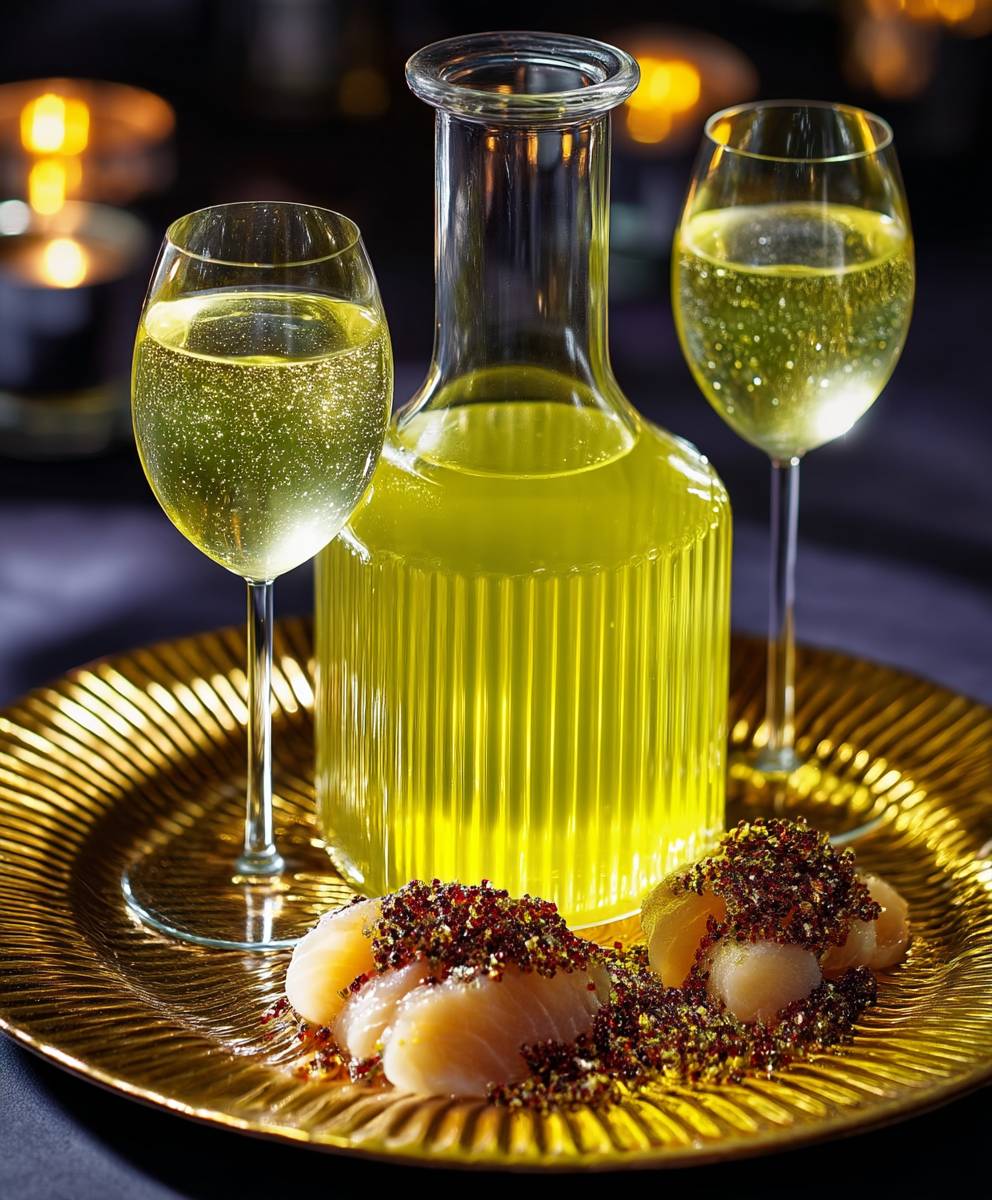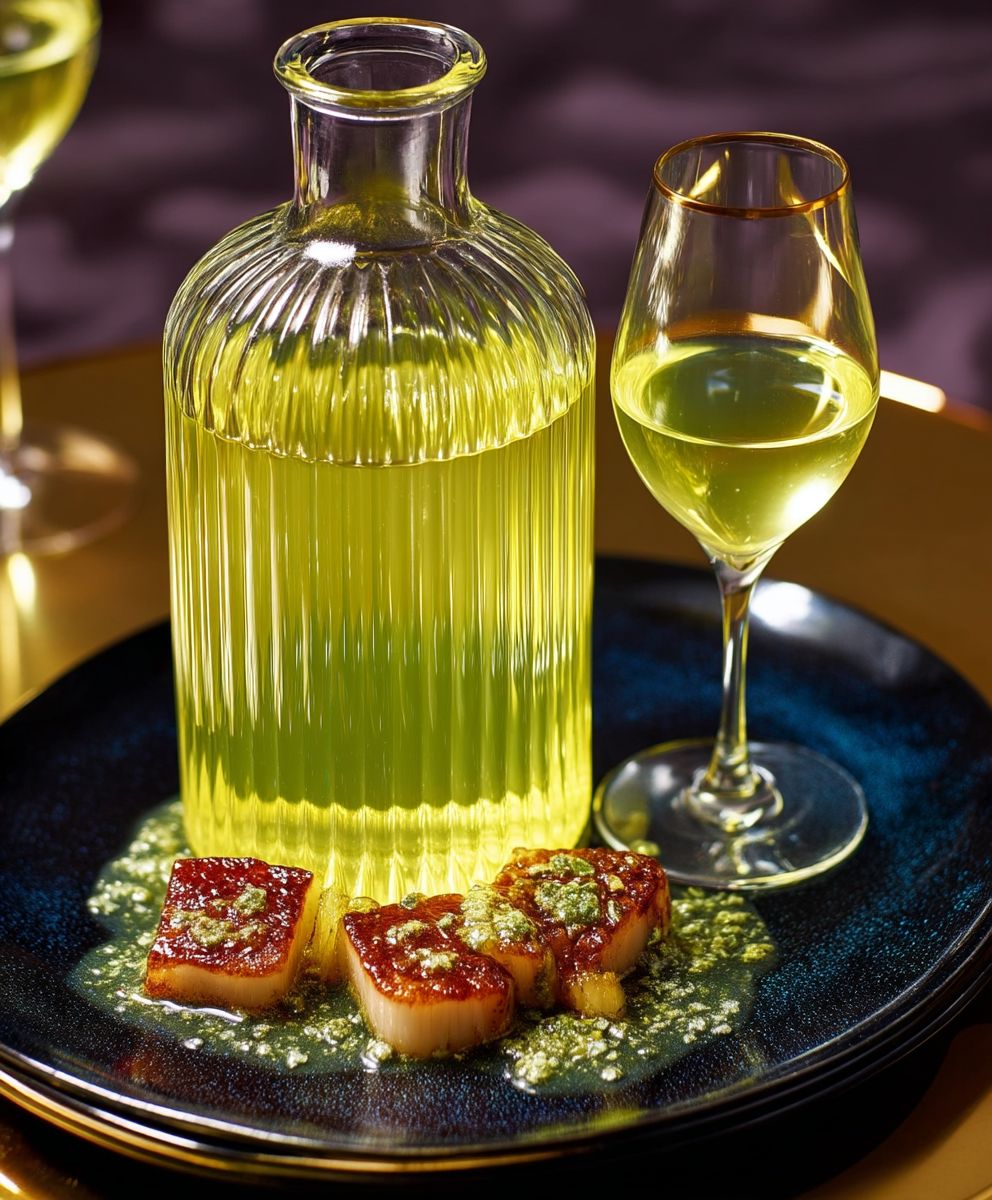Limoncello sous vide: Prepare to unlock a world of citrusy sunshine in a bottle! Forget everything you thought you knew about making this classic Italian liqueur. We’re taking a modern approach to a time-honored tradition, and the results are simply breathtaking. Imagine a limoncello so intensely flavored, so smooth, and so vibrant, it will transport you straight to the Amalfi Coast with every sip.
Limoncello, with its bright yellow hue and invigorating aroma, has been a staple in Italian households for generations. Legend has it that the recipe originated in Southern Italy, possibly on the island of Capri, where families guarded their secret methods for producing the perfect batch. Traditionally, it involves steeping lemon peels in alcohol for an extended period, followed by the addition of simple syrup. But we’re about to elevate this process using the precision and control of sous vide cooking.
Why do people adore limoncello? It’s more than just a drink; it’s an experience. The zesty, sweet, and slightly tart flavor is incredibly refreshing, making it the perfect digestivo after a hearty meal. Its vibrant color and invigorating aroma instantly uplift the spirits. And now, with this limoncello sous vide recipe, you can achieve an unparalleled level of flavor extraction and consistency, creating a liqueur that’s smoother, brighter, and more intensely lemony than ever before. Get ready to impress your friends and family with this modern twist on a classic Italian favorite!
Ingredients:
- 1 (750ml) bottle of vodka (80 proof or higher)
- 8-10 lemons (organic, unwaxed preferred)
- 3 cups granulated sugar
- 3 cups water
Preparing the Lemon Infusion (Sous Vide)
Alright, let’s get started! The key to a vibrant and flavorful limoncello is extracting the lemon’s essence without the bitter white pith. The sous vide method helps us achieve this beautifully.
- Wash and Prepare the Lemons: Thoroughly wash the lemons under warm water. If they aren’t organic, give them a good scrub to remove any wax coating. Pat them dry.
- Zest the Lemons: This is arguably the most important step. Using a vegetable peeler or a microplane, carefully zest the lemons, removing only the yellow part of the peel. Avoid the white pith underneath, as it will make your limoncello bitter. Aim for long, wide strips of zest. You should have about 1/2 cup to 3/4 cup of zest. Tip: If using a vegetable peeler, you can scrape off any remaining pith with a knife after peeling.
- Combine Zest and Vodka: Place the lemon zest into a large, resealable freezer bag (gallon size works well). Pour the entire bottle of vodka over the zest.
- Sous Vide Time and Temperature: Seal the bag using the water displacement method (slowly lower the bag into water, allowing the air to escape before sealing the last corner). This ensures good contact between the vodka and the zest. Set your sous vide immersion circulator to 135°F (57°C). Submerge the bag in the water bath and let it cook for 2 hours. This gentle heat extracts the lemon oils without overcooking the zest and releasing bitterness.
- Cooling the Infusion: After 2 hours, carefully remove the bag from the water bath. Let it cool completely at room temperature. This can take a couple of hours. You can speed up the cooling process by placing the bag in an ice bath.
Preparing the Simple Syrup
While the vodka is infusing, let’s make the simple syrup. This will add the sweetness and body to our limoncello.
- Combine Water and Sugar: In a medium saucepan, combine the water and sugar.
- Heat and Dissolve: Place the saucepan over medium heat. Stir constantly until the sugar is completely dissolved and the mixture is clear. Do not let it boil.
- Cool the Syrup: Remove the saucepan from the heat and let the simple syrup cool completely. This is crucial! Adding hot syrup to the vodka infusion can cloud the limoncello.
Combining and Filtering
Now for the exciting part bringing everything together!
- Strain the Infusion: Once the vodka infusion has cooled completely, strain it through a fine-mesh sieve lined with cheesecloth. This will remove the lemon zest and any sediment. Discard the zest. Tip: Don’t squeeze the zest too hard, as this can release bitter compounds.
- Combine Infusion and Syrup: Pour the cooled simple syrup into the strained vodka infusion. Stir gently to combine.
- Taste and Adjust: Taste the limoncello. If it’s too strong, you can add a little more water. If it’s not sweet enough, you can make a little more simple syrup (using a 1:1 ratio of sugar to water) and add it to the mixture. Remember to let the additional syrup cool completely before adding it.
- Filtering (Optional but Recommended): For the clearest limoncello, you can filter it again. Use a coffee filter or a very fine cheesecloth to remove any remaining particles. This step can take some time, as the liquid will drip through slowly.
Bottling and Aging
Almost there! Now we just need to bottle and let the flavors meld.
- Bottle the Limoncello: Pour the limoncello into clean, airtight bottles. Glass bottles are ideal.
- Aging (Important!): This is where the magic happens. Store the bottled limoncello in the freezer for at least two weeks, and preferably longer (a month or two is even better). This allows the flavors to fully develop and mellow out. The alcohol content will prevent it from freezing solid.
Serving and Enjoying
Finally! Your homemade limoncello is ready to be enjoyed.
- Serving: Serve the limoncello ice cold, straight from the freezer. It’s traditionally served in small glasses as an after-dinner digestif.
- Enjoy! Savor the bright, citrusy flavor of your homemade limoncello. It’s perfect on its own or as an ingredient in cocktails.
Tips and Variations:
- Lemon Variety: The type of lemon you use will affect the flavor of your limoncello. Meyer lemons are sweeter and less acidic than Eureka lemons. Experiment to find your favorite!
- Vodka Quality: While you don’t need to use the most expensive vodka, avoid the bottom-shelf stuff. A decent mid-range vodka will give you the best results.
- Infusion Time: While the sous vide method is relatively quick, you can also infuse the vodka at room temperature. Simply combine the zest and vodka in a jar and let it sit for 2-4 weeks, shaking it occasionally. Strain and proceed with the recipe.
- Other Citrus: Get creative! You can use this recipe as a base for other citrus liqueurs, such as orangecello (using orange zest) or grapefruitcello (using grapefruit zest).
- Sweetness Level: Adjust the amount of simple syrup to your liking. Some people prefer a sweeter limoncello, while others prefer a more tart one.
- Cloudiness: Sometimes, limoncello can become cloudy, especially after being refrigerated. This is usually due to the lemon oils solidifying. It’s perfectly safe to drink, but if you prefer a clear limoncello, you can try filtering it again or letting it sit at room temperature for a while.
Troubleshooting:
- Bitter Limoncello: If your limoncello is bitter, it’s likely due to too much pith in the zest. Next time, be more careful when zesting the lemons. You can also try adding a little more sugar to mask the bitterness.
- Weak Lemon Flavor: If the lemon flavor is weak, try using more lemon zest or infusing the vodka for a longer period of time.
- Cloudy Limoncello: As mentioned above, cloudiness is usually due to the lemon oils solidifying. Filtering can help, but it’s not always a perfect solution.
Making limoncello at home is a rewarding experience. It’s a delicious and refreshing drink that’s perfect for any occasion. With a little patience and attention to detail, you can create a limoncello that’s even better than store-bought!

Conclusion:
So, there you have it! This Limoncello sous vide recipe is truly a game-changer. Forget the days of waiting weeks for your limoncello to infuse. With this method, you get a vibrant, intensely flavored liqueur in a fraction of the time. The sous vide technique unlocks the essential oils in the lemon peels like never before, resulting in a smoother, less bitter, and far more aromatic limoncello than you could ever achieve with traditional methods. Trust me, once you taste the difference, you’ll never go back!
Why is this a must-try? Because it’s easy, efficient, and delivers unparalleled flavor. It’s the perfect project for a weekend afternoon, and the results are guaranteed to impress. Imagine serving this homemade limoncello to your friends and family they’ll be blown away by the bright, citrusy taste and the fact that you made it yourself! It’s a fantastic conversation starter and a truly unique gift idea.
But the fun doesn’t stop there! This limoncello is incredibly versatile. Of course, it’s delicious served ice-cold as a digestif after a meal. But you can also use it to elevate your cocktails. Try adding a splash to your favorite spritzer for a refreshing summer drink. Or, use it in a lemon drop martini for an extra burst of citrus flavor. It’s also fantastic drizzled over fresh fruit, especially berries, or used to soak ladyfingers for a decadent tiramisu. For a non-alcoholic twist, consider using the infused lemon peels (after removing them from the limoncello) to flavor homemade lemonade or iced tea. The possibilities are endless!
Serving Suggestions and Variations:
- Classic Digestif: Serve chilled in small glasses after dinner.
- Limoncello Spritzer: Combine limoncello with Prosecco and a splash of soda water. Garnish with a lemon slice.
- Lemon Drop Martini: Shake limoncello with vodka, simple syrup, and lemon juice. Strain into a chilled martini glass.
- Limoncello Tiramisu: Soak ladyfingers in limoncello before layering with mascarpone cream.
- Limoncello Granita: Freeze limoncello and scrape with a fork to create a refreshing granita.
- Spicy Limoncello: Add a few slices of fresh ginger or a pinch of chili flakes to the sous vide bag for a spicy kick.
- Herbaceous Limoncello: Include a sprig of fresh rosemary or thyme in the sous vide bag for an herbaceous note.
I’m so excited for you to try this recipe! I truly believe that this Limoncello sous vide method will revolutionize your homemade liqueur game. It’s a simple technique with extraordinary results. Once you’ve made your own batch, I’d love to hear about your experience. Did you try any variations? What did you serve it with? Share your photos and stories in the comments below! Let’s create a community of limoncello lovers and inspire each other with new and exciting ways to enjoy this delicious liqueur. Don’t be shy give it a try and let me know what you think. Happy infusing!
I can’t wait to see what you create! Remember to always drink responsibly and enjoy the fruits (or lemons!) of your labor. Cheers!
Limoncello Sous Vide: The Ultimate Guide to Homemade Perfection
A vibrant and refreshing homemade Italian lemon liqueur made with vodka, fresh lemon zest, and simple syrup. This recipe uses the sous vide method for optimal flavor extraction.
Ingredients
- 1 (750ml) bottle of vodka (80 proof or higher)
- 8-10 lemons (organic, unwaxed preferred)
- 3 cups granulated sugar
- 3 cups water
Instructions
- Thoroughly wash the lemons under warm water. If they aren’t organic, give them a good scrub to remove any wax coating. Pat them dry.
- Using a vegetable peeler or a microplane, carefully zest the lemons, removing only the yellow part of the peel. Avoid the white pith underneath, as it will make your limoncello bitter. Aim for long, wide strips of zest. You should have about 1/2 cup to 3/4 cup of zest.
- Place the lemon zest into a large, resealable freezer bag (gallon size works well). Pour the entire bottle of vodka over the zest.
- Seal the bag using the water displacement method (slowly lower the bag into water, allowing the air to escape before sealing the last corner). Set your sous vide immersion circulator to 135°F (57°C). Submerge the bag in the water bath and let it cook for 2 hours.
- After 2 hours, carefully remove the bag from the water bath. Let it cool completely at room temperature. This can take a couple of hours. You can speed up the cooling process by placing the bag in an ice bath.
- In a medium saucepan, combine the water and sugar.
- Place the saucepan over medium heat. Stir constantly until the sugar is completely dissolved and the mixture is clear. Do not let it boil.
- Remove the saucepan from the heat and let the simple syrup cool completely.
- Once the vodka infusion has cooled completely, strain it through a fine-mesh sieve lined with cheesecloth. Discard the zest.
- Pour the cooled simple syrup into the strained vodka infusion. Stir gently to combine.
- Taste the limoncello. If it’s too strong, you can add a little more water. If it’s not sweet enough, you can make a little more simple syrup (using a 1:1 ratio of sugar to water) and add it to the mixture. Remember to let the additional syrup cool completely before adding it.
- For the clearest limoncello, you can filter it again. Use a coffee filter or a very fine cheesecloth to remove any remaining particles. This step can take some time, as the liquid will drip through slowly.
- Pour the limoncello into clean, airtight bottles. Glass bottles are ideal.
- Store the bottled limoncello in the freezer for at least two weeks, and preferably longer (a month or two is even better). This allows the flavors to fully develop and mellow out. The alcohol content will prevent it from freezing solid.
- Serve the limoncello ice cold, straight from the freezer. It’s traditionally served in small glasses as an after-dinner digestif.
- Savor the bright, citrusy flavor of your homemade limoncello. It’s perfect on its own or as an ingredient in cocktails.
Notes
- The type of lemon you use will affect the flavor of your limoncello. Meyer lemons are sweeter and less acidic than Eureka lemons. Experiment to find your favorite!
- While you don’t need to use the most expensive vodka, avoid the bottom-shelf stuff. A decent mid-range vodka will give you the best results.
- While the sous vide method is relatively quick, you can also infuse the vodka at room temperature. Simply combine the zest and vodka in a jar and let it sit for 2-4 weeks, shaking it occasionally. Strain and proceed with the recipe.
- Get creative! You can use this recipe as a base for other citrus liqueurs, such as orangecello (using orange zest) or grapefruitcello (using grapefruit zest).
- Adjust the amount of simple syrup to your liking. Some people prefer a sweeter limoncello, while others prefer a more tart one.
- Sometimes, limoncello can become cloudy, especially after being refrigerated. This is usually due to the lemon oils solidifying. It’s perfectly safe to drink, but if you prefer a clear limoncello, you can try filtering it again or letting it sit at room temperature for a while.
- If your limoncello is bitter, it’s likely due to too much pith in the zest. Next time, be more careful when zesting the lemons. You can also try adding a little more sugar to mask the bitterness.
- If the lemon flavor is weak, try using more lemon zest or infusing the vodka for a longer period of time.





Leave a Comment